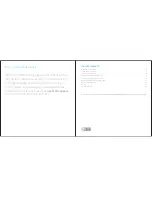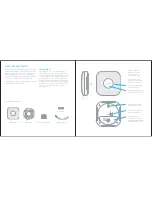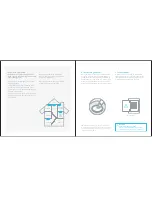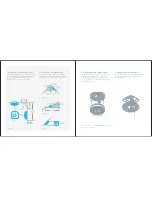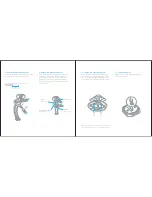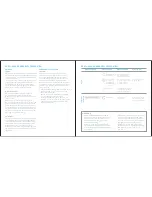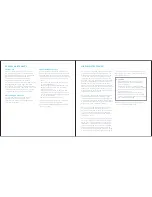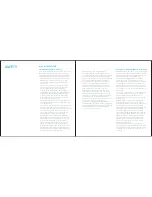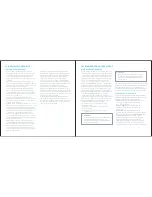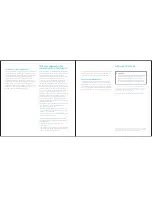
31
30
more information about CO safety and this
equipment. Make sure that motor vehicles
are not, and have not been, operating in an
attached garage or adjacent to the residence.
This information is available as a label provided
in the box. Stick it in a spot where everyone can
see it, like the refrigerator.
THE FOLLOWING CONDITIONS CAN RESULT IN
TRANSIENT CO SITUATIONS
1. Excessive spillage or reverse venting of fuel
burning appliances caused by:
I) Outdoor ambient conditions such as wind
direction and/or velocity, including high
gusts of wind; heavy air in the vent pipes
(cold/humid air with extended periods
between cycles).
II) Negative pressure differential resulting
from the use of exhaust fans.
III) Simultaneous operation of several fuel
burning appliances competing for limited
internal air.
IV) Vent pipe connection vibrating loose from
clothes dryers, furnaces, or water heaters.
V) Obstructions in or unconventional vent pipe
designs which amplify the above situations.
2. Extended operation of unvented fuel burning
devices (range, oven, fireplace, etc.).
3. Temperature inversions which can trap
exhaust gases near the ground.
4. Car idling in an open or closed attached
garage, or near a home.
5. NEVER bring a charcoal grill inside and
ALWAYS operate a portable generator
outside, a safe distance from the house,
and well away from windows.
WHAT TO DO IN CASE OF A CARBON
MONOXIDE ALARM
WARNING
Actuation of your CO alarm indicates the
presence of carbon monoxide (CO) which
can KILL YOU.
If alarm signal sounds:
1) Operate reset/silence button (Press
Nest button);
2) Call your emergency services [fire dept. or 911];
PHONE NUMBER:
3) Immediately move to fresh air – outdoors or
by an open door/window. Do a head count to
check that all persons are accounted for. Do
not reenter the premises nor move away from
the open door/window until the emergency
services responders have arrived, the
premises have been aired out, and your alarm
remains in its normal condition.
4) After following steps 1 – 3, if your alarm
reactivates within a 24-hour period, repeat steps
1 – 3 and call a qualified appliance technician
PHONE NUMBER:
to investigate for sources of CO from
fuel burning equipment and appliances,
and inspect for proper operation of this
equipment. If problems are identified
during this inspection have the equipment
serviced immediately. Note any combustion
equipment not inspected by the technician
and consult the manufacturers’ instructions,
or contact the manufacturers directly, for
FIRE SAFETY PRECAUTIONS
CREATE AN ESCAPE PLAN TO PRACTICE
Be prepared when your smoke/CO alarm
sounds its alarm. Develop a family escape
plan, discuss it with all household members,
and practice it regularly.
• Make sure everyone is familiar with the sound
of your smoke/ CO alarm and explain what the
sound means.
• Determine TWO exits from each room and
have an escape route to the outside from
each exit.
• Teach all the members in your household to
check doors for heat with the back of your
hand before opening them, and to use the
alternate exit if the door is hot. Make sure
they do not open the door if it is hot.
• Teach household members to crawl along
the floor to avoid dangerous smoke, fumes
and gases.
• Determine a safe meeting place for all
household members to regroup at outside
the building.
PRACTICE FIRE SAFETY
Practice your escape plan at least twice a year,
making sure that everyone is involved – from kids
to grandparents. Practice the escape plan with
children, including holding one at night when they
are sleeping. If children or others do not wake
up to the sound of the smoke alarm, or if there
are infants or family members with mobility
limitations, make sure that someone is assigned
to help them for the fire drill and in the event
of an emergency. Current studies have shown
smoke alarms may not awaken all sleeping
individuals, and that it is the responsibility of
individuals in the household that are capable of
assisting others to provide assistance to those
who may not be awakened by the alarm sound,
or to those who may be incapable of safely
evacuating the area unassisted.
WHAT TO DO IN CASE OF FIRE
• Get out now.
• Don’t panic; stay calm.
• Operate your safety plan as previously
planned.
• Alert small children in the home and those
who may need extra assistance.
• Leave the building as quickly as possible.
Touch doors with the back of your hand and
make sure they are not hot before opening
them. Use an alternate exit, if necessary.
In case of smoke, crawl along the floor, and
DO NOT stop to collect anything. Close the
doors behind you.
• Meet at a pre-arranged meeting place outside
the building.
• Once outside, do a head count, and call the
fire department.
• DO NOT reenter the house, unless a fire
official says it’s safe to reenter.

